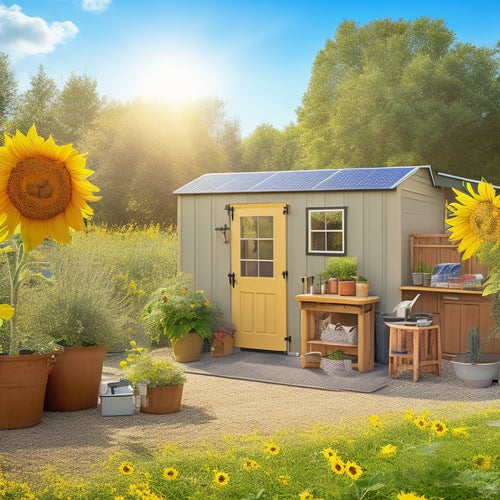
5 Tips for Heating With Renewable Energy
Share
You can greatly reduce your carbon footprint and energy bills by switching to renewable energy sources for heating. To get started, verify correct installation of solar thermal systems to maximize energy output. Next, assess your home's insulation, window orientation, and local building codes to guarantee seamless integration. Consider utilizing sunlight for heat through passive solar design principles and thermal mass materials. You'll also want to optimize energy efficiency through insulation upgrades, air leak sealing, and strategic window placement. By following these initial steps, you'll be well on your way to revealing the full potential of renewable energy heating - and there's more to investigate.
Overview
- Verify correct installation of solar thermal systems to maximize energy output and ensure seamless integration with existing infrastructure.
- Assess your home's insulation, window orientation, and local building codes to optimize passive solar design principles and energy efficiency.
- Consider off-grid solar power systems to ensure a consistent energy supply and reduce reliance on traditional energy sources.
- Conduct energy audits to identify energy waste areas and prioritize specific improvements to maximize energy efficiency and reduce consumption.
- Incorporate thermal mass materials and strategic window placement to regulate temperature naturally and reduce the need for supplemental heating.
Installing Solar Thermal Systems
Efficiency is key when it comes to utilizing the sun's energy for your home's heating needs. When installing a solar thermal system, you'll want to verify that it's done correctly to maximize energy output. Proper system installation involves evaluating your home's insulation, window orientation, and local building codes.
Think about hiring a professional to guarantee a seamless integration with your existing heating system. Furthermore, it's crucial to reflect on the structural soundness of your roof rooftop installation as well as the energy storage needs and potential for system expansion when planning.
Regular maintenance tips include checking the system's fluid levels, inspecting pipes for damage, and cleaning the solar collectors to prevent debris buildup. By following these guidelines, you'll be able to enjoy the freedom and cost-effectiveness of renewable energy heating for years to come.
Harnessing Sunlight for Heat
Your solar thermal system is ready to convert sunlight into heat, but how does it actually work? It's quite simple. The system absorbs sunlight, which heats up a fluid that's then circulated through a network of pipes.
This warm fluid is used to heat your home, providing a sustainable and eco-friendly alternative to traditional heating methods. With a reliable off-grid solar power system high-efficiency panels in place, you can guarantee a consistent energy supply to power your heating needs.
By incorporating passive solar design principles, such as large south-facing windows and thermal mass materials, you can optimize the system's efficiency. Thermal mass materials, like concrete or brick, absorb heat during the day and release it at night, providing a natural temperature regulation.
Solar Water Heating Benefits
As you investigate the possibilities of solar thermal systems, you'll find that one of the most practical applications is solar water heating. This eco-friendly solution reduces your reliance on traditional energy sources, resulting in significant cost savings.
By utilizing sunlight to heat your water, you can cut your energy bills by up to 70%. Furthermore, solar water heating has a minimal environmental impact, producing no emissions or pollution.
When considering solar water heating, it's crucial to assess the system size and complexity to guarantee peak performance and cost-effectiveness.
With a typical lifespan of 20 years or more, these systems provide a long-term solution for your hot water needs. By investing in solar water heating, you'll not only save money but also contribute to a cleaner, more sustainable future.
Space Heating With Solar Power
About 40% of the energy consumed in a typical household goes towards space heating, making it an ideal target for solar power integration. You can greatly reduce your reliance on fossil fuels by incorporating solar heating systems into your home.
One effective approach is to incorporate passive solar design principles into your building's structure. This can include orienting your home to face the sun, using thermal mass materials to absorb and release heat, and strategically placing windows and insulation to maximize natural heat gain.
Maximizing Energy Efficiency
Incorporating solar heating systems into your home is just the first step towards reducing your reliance on fossil fuels. To maximize energy efficiency, you'll need to go further. Start by conducting energy audits to identify areas where energy is being wasted. This will help you pinpoint specific improvements you can make, such as insulation upgrades, to reduce heat loss and optimize your solar heating system's performance.
| Energy Efficiency Measure | Benefits |
|---|---|
| Conduct energy audits | Identify areas of energy waste, prioritize improvements |
| Insulation upgrades | Reduce heat loss, optimize solar heating performance |
| Seal air leaks | Prevent heat from escaping, reduce energy consumption |
Frequently Asked Questions
Can I Use Renewable Energy to Heat My Pool?
You can heat your pool with renewable energy by installing a solar pool heater or leveraging geothermal heating, which utilizes the earth's natural heat, reducing your carbon footprint and energy bills while giving you freedom from fossil fuels.
How Does Renewable Energy Heating Affect My Home's Value?
You're investing in a renewable energy heating system, and it's like planting a tree - it grows in value over time. By increasing your home's energy efficiency, you'll enhance its value, making it more attractive to potential buyers and securing a higher resale price.
Are Renewable Energy Heating Systems Noisy or Disruptive?
You'll find that renewable energy heating systems typically operate at moderate sound levels, but efficient system design and proper installation can minimize noise. Installation may be noisy, but maintenance disruptions are rare, ensuring comfort factors while keeping noise reduction in mind.
Can I Use Renewable Energy for Heating in Cold Climates?
As you venture into the frozen tundra, you'll find that geothermal heat and solar thermal systems can be your trusty guides, utilizing the earth's warmth and sun's rays to keep your home cozy, even in the chilliest of climates.
Are Government Incentives Available for Renewable Energy Heating?
You can tap into various government incentives for renewable energy heating, including tax credits, energy rebates, installation grants, and financial assistance, such as solar incentives and biomass programs, to offset the costs and maximize your savings.
Ready to Buy
As you maneuver through the shift to renewable energy, remember that heating with solar power is like finding a hidden key to revealing a wealth of savings and sustainability. By installing solar thermal systems, utilizing sunlight for heat, and maximizing energy efficiency, you'll be well on your way to reducing your carbon footprint. With these 5 tips, you'll be able to tap into the abundant energy of the sun, just like a precision-crafted machine, and reap the benefits of a warmer, greener future.
Related Posts
-

Building an Emergency Backup Solar Power System in 5 Essential Steps
Building an emergency backup solar power system involves five key steps. First, assess your daily energy needs to ide...
-

Is Switching to Green Energy Solutions Easy
Switching to green energy solutions isn't just easy; it's also beneficial. You can greatly cut utility costs and enjo...
-

Smart Grid Technology Implementation Challenges
You'll encounter several challenges when implementing smart grid technology, particularly in cost management, scalabi...


